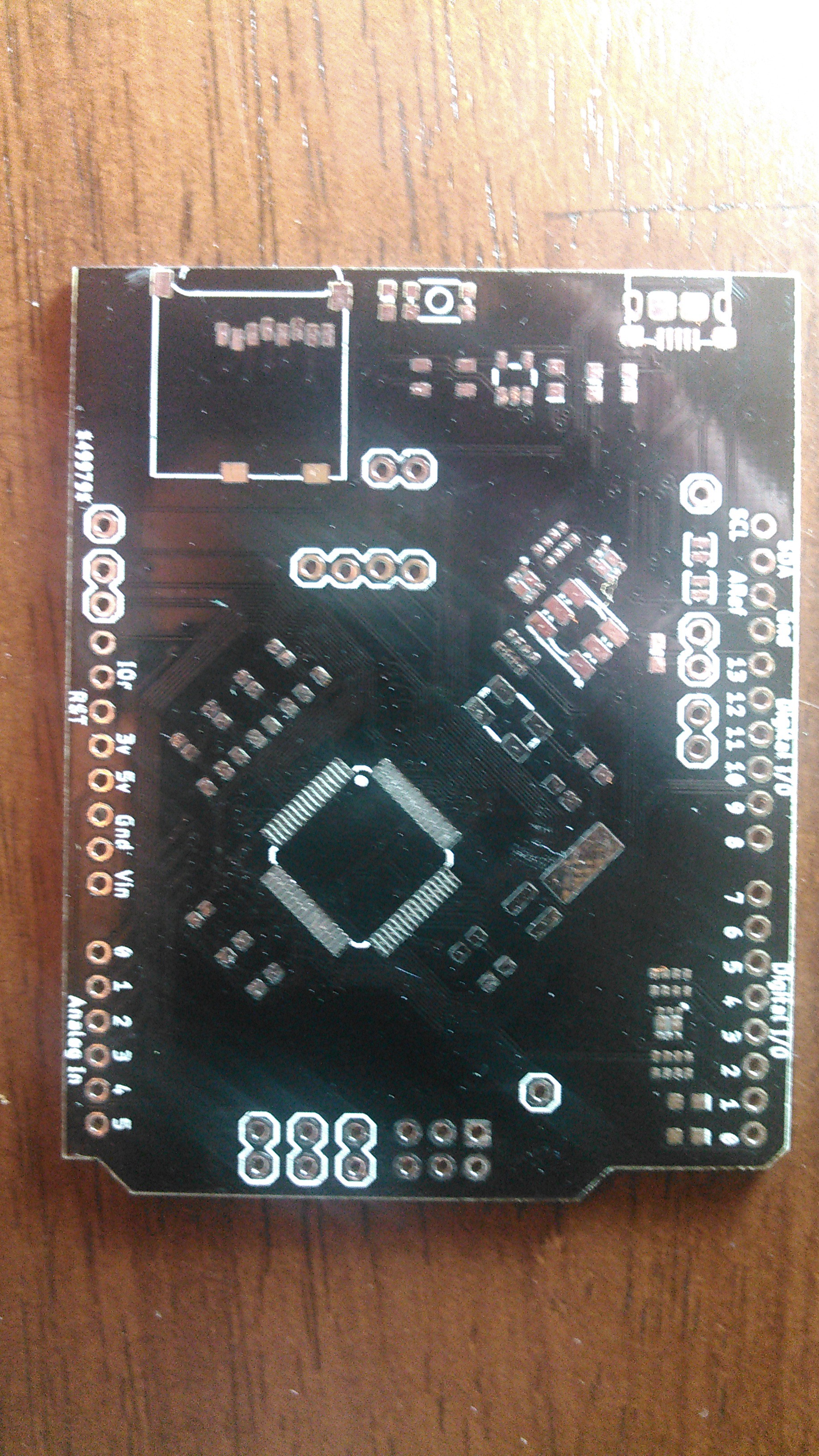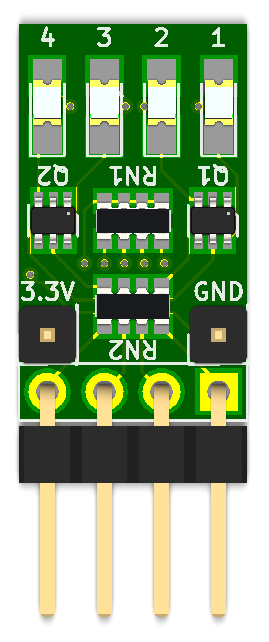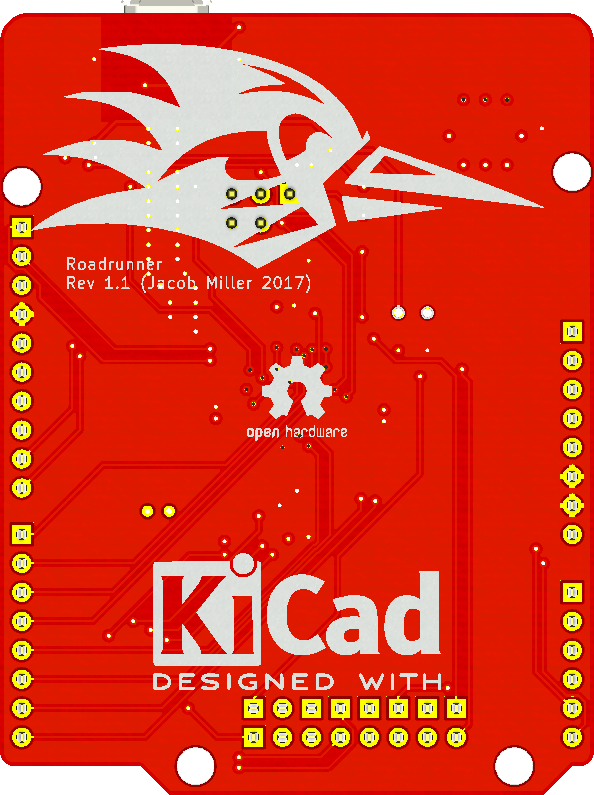-
Tentative Rev. 2
03/30/2018 at 23:31 • 0 comments![]()
ROADRUNNER Mouser # Mfr. # Manufacturer Customer # Description 595-TM4C123GH6PMI TM4C123GH6PMI Texas Instruments ARM Microcontrollers - MCU Tiva C Series MCU 512-FDMA1024NZ FDMA1024NZ ON Semiconductor MOSFET 20V Dual N-Channel PowerTrench 649-10118193-0001LF 10118193-0001LF FCI / Amphenol USB Connectors 5P MICRO USB TYPE B RECEPTACLE W/ PEGS 621-AP2112K-3.3TRG1 AP2112K-3.3TRG1 Diodes Incorporated LDO Voltage Regulators 600mA CMOS LDO 50mA 3.3V 250mV 611-KMR421NGLFS KMR421NG LFS C&K Switches Tactile Switches Tact 517-2908-05WB-MG 2908-05WB-MG 3M Memory Card Connectors MICROSD 8P P/P SMT POLARIZED 604-AP1608SRCPRV AP1608SRCPRV Kingbright Standard LEDs - SMD RED WATER CLEAR 604-APT1608SGC APT1608SGC Kingbright Standard LEDs - SMD GREEN WATER CLEAR 604-APT1608QBC/D APT1608QBC/D Kingbright Standard LEDs - SMD Blue 470nm Water Clear 100mcd 594-MCT06030C1002FP5 MCT06030C1002FP500 Vishay Thin Film Resistors - SMD .1W 10Kohms 1% 0603 50ppm Auto 603-RC0603FR-071ML RC0603FR-071ML Yageo 520-.327-12.5-13FLXC ECS-.327-12.5-13FLX-C ECS Crystals 32.768KHz 12.5pF 10ppm -40C +85C 449-LFXTAL035945REEL LFXTAL035945Reel IQD Frequency Products Crystals 16MHz 18pF -10C 60C 667-EXB-V8V750JV EXB-V8V750JV Panasonic Resistor Networks & Arrays 75 OHM 5>#/td### 667-EXB-38V103JV EXB-38V103JV Panasonic Resistor Networks & Arrays 10K OHM 5>#/td### 710-885012006002 885012006002 Wurth Electronics Multilayer Ceramic Capacitors MLCC - SMD/SMT WCAP-CSGP 10pF 0603 5% 10V MLCC 77-VJ0805Y105KXQTBC VJ0805Y105KXQTW1BC Vishay Multilayer Ceramic Capacitors MLCC - SMD/SMT 0805 1uF 10volts X7R 10>#/td### 963-LMK212BBJ226MG-T LMK212BBJ226MG-T Taiyo Yuden Multilayer Ceramic Capacitors MLCC - SMD/SMT 22uF 10V X5R +/-20% 0805 Gen Purp 710-885012106011 885012106011 Wurth Electronics Multilayer Ceramic Capacitors MLCC - SMD/SMT WCAP-CSGP 2.2F 0603 20% 10V MLCC 603-CC603JRNPO9BN240 CC0603JRNPO9BN240 Yageo Multilayer Ceramic Capacitors MLCC - SMD/SMT 24pF 50V NPO 5>#/td### 710-885012105018 885012105018 Wurth Electronics Multilayer Ceramic Capacitors MLCC - SMD/SMT WCAP-CSGP 100000pF 0402 20% 25V MLCC 859-LTST-G563EGBW LTST-G563EGBW Lite-On Standard LEDs - SMD SMD LED Red/Grn/Blue 840/2100/420 mcd -
Progress Update
09/07/2017 at 10:07 • 1 commentI've completed the little side project, a MOSFET switched LED indicator board. I was able to practice using hot air to solder the components all at once. This project gives me confidence that the LED circuit will work as expected in revision 2 of the Roadrunner and that I can use hot air to solder the components. That last part will be a huge time saver!
I'll have the boards fabricated within the next month or so as time allows. And after the usual round of testing I think I'll be ready to begin offering them to those interested.
-
Detour Project
08/05/2017 at 20:01 • 0 commentsHave you ever been in the middle of testing some DIY thingy and though to yourself, "It wish I had a ____ to help me test this". So while I was testing all the pins on this board I thought it would be nice to have a simple board with LED's I could plug into the headers to help testing go faster. I also wanted to add more LED's to the new board revision and properly make use of MOSFETs to drive them, instead of sourcing current directly from the μC. So I decided to whip up a simple board with 4 LED's driven by MOSFETs. So I came up with the "Nibbler". I'll probably post a quick project page documenting this. I'll also get to try soldering some 1208 resistor arrays.
-
Board Layout Update v1.1.2
07/31/2017 at 20:10 • 0 commentsI decided to make a few more modifications to the board. I wanted to simplify component placement so I switched some of the single resistors over to resistor arrays, specifically on the LEDs. I also decided to drive the LED's properly by using MOSFET switches instead of directly from IO pins.
I still need to update my pin out diagram and modify the pin assignment in the software, but that can wait until I actually spin a few of these for testing.
![]()
-
Board Layout Update
07/20/2017 at 02:54 • 0 commentsI've just about completed reworking the layout to be fully pin compatible with the Uno / Leonardo pin layouts. Additionally I've reorganized the extra pins at the bottom of the board and added some custom artwork.
These are renders of what the finished layout will most likely look like. I've spent enough time tweaking.
![]()
![]()
-
Linux Flashing Works
07/01/2017 at 01:47 • 0 commentsI just finished getting the flash tool running on Linux (Ubuntu 16.04 LTS). Github has been updated with the most recent changes. It's works most of the time, but sometimes the board fails to switch into DFU mode and sometimes fails to switch out of it. Not sure if this is a Linux or Tiva software issue yet.
The code for both targets of tiva-dfu-prog need to be cleaned up. Since they are both based on existing oss tools they each have a lot of "leftovers" in their baselines that could be removed.
The Linux tool is based on "dfu-util" and the windows version is based on "dfuprog" from TivaWare. Both of the parent projects were converted to c++ and compile with c++11 libraries, since I enjoy the niceties of that language. After cleaning up the code and comments I'll tag each repo.
-
Flashing in Arduino / Energia IDE Complete
06/16/2017 at 19:41 • 1 commentI've just completed building, integrating and testing the custom DFU programmer in doth Arduino and Energia. I'll publish the board manager JSON file and support packages to github shortly. I'm pleased with how relatively smooth the integration went. I've learned a lot about integrating custom board support packages into Arduino along the way and will do a write about the process soon since I found it convoluted at first myself.
The only thing left to do before releasing this into the wild is to add Linux support and do some minor fixes to the board layout.
If this was crowdfunded for small run of 100 boards, probably priced at $30, would you be in?
-
Flashing in Windows - Progress
06/15/2017 at 04:35 • 0 commentsI've almost completed putting together the program to initiate DFU mode and flash the board from within Arduino / Energia. It's pieced together from source code provided by TI in their TivaWare sdk. This will be a Windows only flashing tool customized to the boot loader process of this particular board. I've not begun the Linux side yet, but my research tells me that it will be a much easier task. I believe "dfu-util" will work for it with only minor modifications.
-
Now with built in USB Virtual COM support
06/10/2017 at 03:08 • 0 commentsI'm claiming 95% success in adding USB VCOM support right out of the box. This means the base Arduino sketch will run with USB VCOM enabled. This allows the board to be powered by USB and enumerate as a virtual com port, even with an empty sketch. In practice, it's modeled after the HardwareSerial class, which instantiates an object called "Serial" object before jumping in "loop()" and running the user sketch. This new class creates an instance called "USBSerial".
So when connected by SB to a host you can use USBSerial.print(), USBSerial.println(), etc to send /receive data over the virtual com port. Additionally, calls to Serial.print, etc. still work, but are tied to the physical pins on the board. If using a TivaC LaunchPad, calls to Serial go over its enumerated debug com port.
The 95% success is due to the way the boot loader is initiated currently. It works, but not as well as I would like.
Next Steps: Modify Arduino IDE to initiate boot loader mode after compiling, then upload over the DFU endpoint.
-
USBlib in Arduino and Energia IDE
06/07/2017 at 22:32 • 0 commentsAfter spending a long ninght working through the Arduino IDE compile options, I was able to add support for TI's USBlib, which is used as part of the boot loader trigger. I decided to emulate he Arduino Loenardo boot loader process. This board appears as a USB VCOM port and connecting to it at 1200 baud causes it to switch into USB DFU mode.
Once I get DFU flashing working from the IDE's I'll post an update to the board package and corresponding json index file.
Roadrunner (the Arduino-Tiva)
An Arduino clone based on a TI's Tiva TM4C123G (An 80Mhz ARM M4F with USB OTG)




